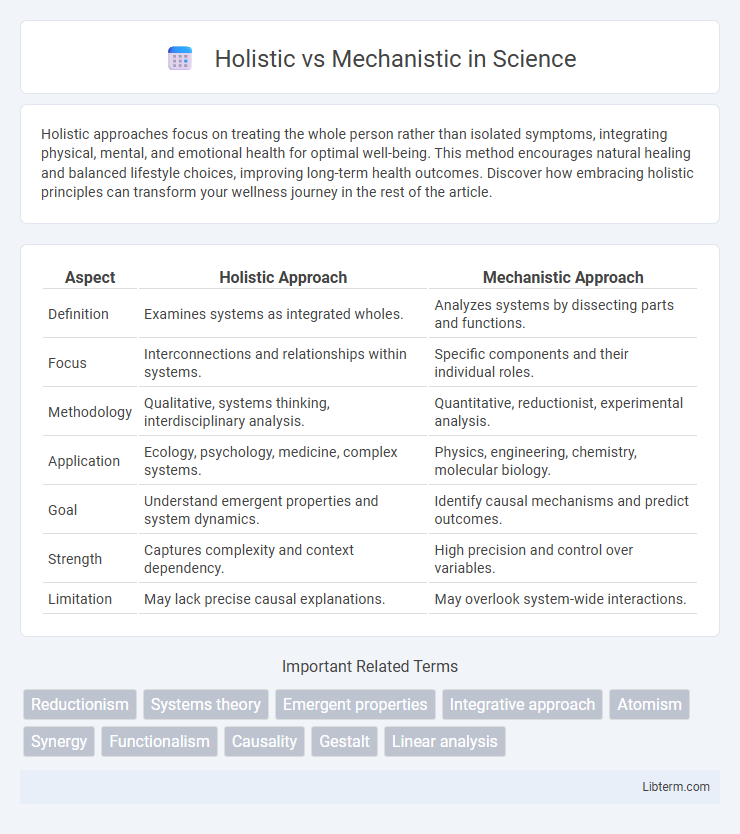Holistic approaches focus on treating the whole person rather than isolated symptoms, integrating physical, mental, and emotional health for optimal well-being. This method encourages natural healing and balanced lifestyle choices, improving long-term health outcomes. Discover how embracing holistic principles can transform your wellness journey in the rest of the article.
Table of Comparison
| Aspect | Holistic Approach | Mechanistic Approach |
|---|---|---|
| Definition | Examines systems as integrated wholes. | Analyzes systems by dissecting parts and functions. |
| Focus | Interconnections and relationships within systems. | Specific components and their individual roles. |
| Methodology | Qualitative, systems thinking, interdisciplinary analysis. | Quantitative, reductionist, experimental analysis. |
| Application | Ecology, psychology, medicine, complex systems. | Physics, engineering, chemistry, molecular biology. |
| Goal | Understand emergent properties and system dynamics. | Identify causal mechanisms and predict outcomes. |
| Strength | Captures complexity and context dependency. | High precision and control over variables. |
| Limitation | May lack precise causal explanations. | May overlook system-wide interactions. |
Introduction to Holistic and Mechanistic Approaches
Holistic and mechanistic approaches represent two distinct perspectives in understanding systems, where holistic emphasizes the integration and interdependence of components within the whole, while mechanistic focuses on individual parts and their specific functions. In a holistic approach, the system is studied as an interconnected entity, which highlights context, relationships, and patterns that contribute to overall behavior. Mechanistic approaches analyze systems by breaking them down into simpler elements, isolating cause-effect relationships to predict outcomes based on component interactions.
Defining Holistic Thinking
Holistic thinking emphasizes understanding systems as integrated wholes, where the relationships and interactions between components shape overall behavior, contrasting with mechanistic thinking that breaks down systems into isolated parts. This approach prioritizes context, patterns, and connections, fostering comprehensive problem-solving and innovative insights in complex environments. Holistic thinking is essential in fields like ecology, psychology, and organizational management, where dynamic interdependencies influence outcomes.
Defining Mechanistic Thinking
Mechanistic thinking defines complex systems by breaking them down into their individual parts and understanding the function of each component in isolation. This approach relies on cause-and-effect relationships, treating systems like machines with predictable and linear interactions. Emphasizing analysis, predictability, and control, mechanistic thinking contrasts with holistic perspectives that consider the entire system and interactions between its parts.
Historical Development of Both Perspectives
The mechanistic perspective emerged during the Scientific Revolution, emphasizing reductionism and the understanding of systems by analyzing their individual parts, heavily influenced by Cartesian dualism and Newtonian physics. The holistic approach gained prominence in the 20th century, driven by systems theory and ecology, advocating for the comprehension of complex systems as integrated wholes rather than isolated components. Key figures such as Ludwig von Bertalanffy in general systems theory and Jan Smuts with his work on holism significantly shaped the historical development of holistic perspectives.
Key Differences Between Holistic and Mechanistic Methods
Holistic methods emphasize understanding systems as integrated wholes, focusing on relationships, patterns, and context, whereas mechanistic methods analyze systems by breaking them into isolated parts to study cause-and-effect. Holistic approaches prioritize adaptability and complexity, making them ideal for dynamic environments, while mechanistic methods rely on predictability and control suited to stable, well-defined conditions. The key difference lies in holistic methods promoting interconnectedness and learning, contrasting with mechanistic methods' emphasis on efficiency and hierarchical structure.
Advantages of Holistic Approaches
Holistic approaches excel by considering the entire system, integrating physical, emotional, and environmental factors for comprehensive well-being. This method enhances personalized care, leading to improved long-term health outcomes and patient satisfaction. Emphasizing interconnectedness allows early identification of root causes, fostering more effective and sustainable solutions.
Benefits of Mechanistic Approaches
Mechanistic approaches provide clear structure and predictability, allowing organizations to efficiently manage complex processes through defined roles and standardized procedures. These systems enhance control and coordination, reducing errors and improving consistency across operations. By emphasizing specialization and hierarchy, mechanistic models facilitate scalability and operational efficiency in stable, routine environments.
Real-World Applications: Case Studies
Holistic approaches in real-world applications emphasize integrated systems, as seen in healthcare models combining physical, mental, and social well-being for improved patient outcomes. Mechanistic methods dominate manufacturing with precise, cause-effect processes optimizing efficiency and consistency in production lines. Case studies from urban planning reveal holistic strategies enhance sustainability by addressing environmental, economic, and social factors simultaneously, whereas mechanistic designs focus on infrastructure functionality and zoning regulations.
Integrating Holistic and Mechanistic Strategies
Integrating holistic and mechanistic strategies enhances organizational effectiveness by combining the broad, interconnected approach of holistic thinking with the detailed, process-oriented focus of mechanistic methods. This fusion allows businesses to address complex challenges through comprehensive understanding while maintaining operational efficiency and precision. Leveraging both perspectives fosters innovation, adaptability, and robust decision-making in dynamic environments.
Conclusion: Choosing the Right Approach
Choosing the right approach between holistic and mechanistic depends on the complexity and nature of the system in question. Holistic methods excel in environments that require understanding of interrelated components and dynamic interactions, as seen in ecosystems or organizational behavior. Mechanistic approaches are more effective for systems with predictable, linear processes, such as manufacturing or engineering tasks, where specific, repeatable outcomes are critical.
Holistic Infographic

 libterm.com
libterm.com